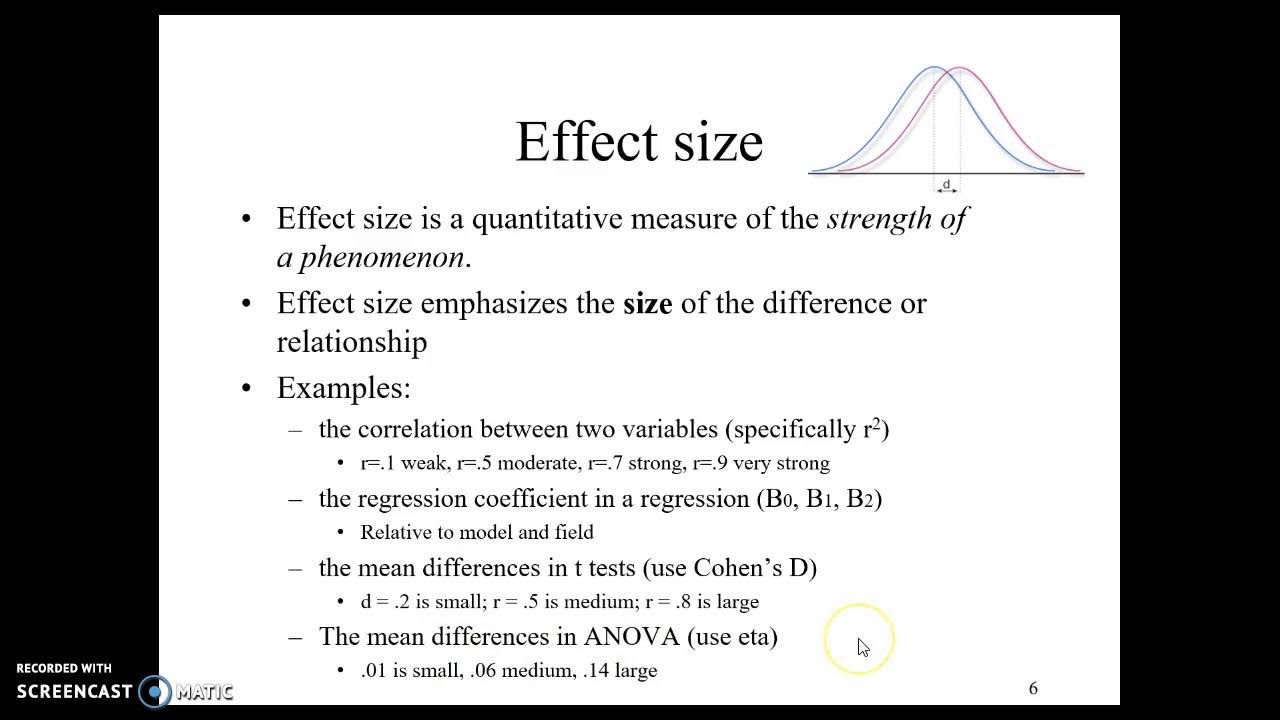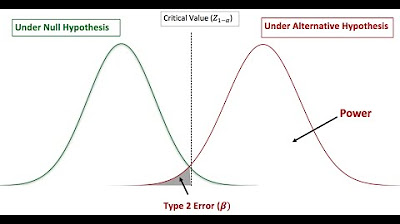Power Analysis and Sample Size Decisions
TLDRThe video script emphasizes the importance of statistical power in study design. It explains that sample size is often arbitrarily chosen without a basis, leading to uninformative studies. Statistical power quantifies the probability of detecting a true effect and depends on effect size, sample size, and alpha level. The script encourages researchers to perform power analysis before data collection to ensure informative results. It also discusses the common issue of unknown effect sizes and suggests making informed judgments or focusing on the smallest effect size of interest. The benefits of a well-powered study include stronger conclusions and avoiding the pitfalls of non-significant findings due to inadequate sample size. The script concludes by advising researchers to consult statisticians or use software for power analysis to improve study design and avoid common heuristics.
Takeaways
- 🔍 The importance of sample size in research is often underestimated, with decisions often based on heuristics rather than a systematic approach.
- 📊 Statistical power is a critical concept for quantifying the probability of detecting a true effect and depends on effect size, sample size, and alpha level.
- 💡 Power analysis should be conducted during the study design phase to ensure that the study is informative and can provide meaningful results about the real world.
- 🚫 Ignoring sample size considerations can lead to uninformative conclusions, especially when non-significant results are obtained due to a small sample size.
- 🤔 Researchers often do not know the effect size in advance, which makes power analysis challenging but necessary for designing an informative study.
- 📉 The lack of power analysis can result in publication bias, where non-significant findings are less likely to be shared or published.
- 🔎 A well-powered study allows for stronger statements about the absence of an effect if non-significant results are obtained, thus providing more confidence in the findings.
- 👨🏫 Seeking help from statisticians or experienced colleagues can be beneficial for those unfamiliar with power analysis.
- 🛠 Power analysis software can provide estimates and help in determining the necessary sample size for a study, making it a valuable tool for researchers.
- 🔮 Power analysis can also help in early decision-making regarding the feasibility of a study, potentially leading to a shift in research focus or collaboration.
- 📈 Improving upon heuristics and rule-of-thumb practices by incorporating power analysis can lead to more informative and better-designed studies.
Q & A
Why is sample size often determined by heuristics rather than a systematic approach in research studies?
-Sample sizes are often determined by heuristics such as '20 participants per condition is enough' due to a lack of understanding or consideration of statistical power and its importance in study design.
What is statistical power in the context of research studies?
-Statistical power is a measure of the probability that a study will detect a true effect if there is one, based on the effect size, sample size, and alpha level chosen for the study.
Why is considering statistical power important when designing a study?
-Statistical power is important because it helps ensure that the study is designed to be informative and capable of detecting meaningful effects, thus avoiding uninformative or inconclusive results.
What is the consequence of not considering sample size before designing a study?
-Not considering sample size can lead to a study that is not sensitive enough to detect significant effects, resulting in inconclusive findings and uncertainty about whether an effect truly exists or was just not observed due to insufficient sample size.
Why is it common not to know the effect size before conducting a power analysis?
-It is common not to know the effect size because if the effect size were already known, there would be no need to collect data; the answer would already be known, making the collection of data redundant.
What is one way to approach power analysis when the effect size is unknown?
-When the effect size is unknown, researchers can make informed judgments based on related theories, previous studies, or decide upon the smallest effect size they care about, ensuring the study is designed to find this minimum effect size of interest.
What is the impact of poorly designed studies on the field of research?
-Poorly designed studies can lead to uninformative results and publication bias, where non-significant findings are less likely to be shared or published, leading to an incomplete understanding of the research landscape.
How can a well-powered study help in making stronger statements about research findings?
-A well-powered study allows researchers to confidently state that they did not observe a significant effect of the smallest size they care about, thus making a stronger statement about the absence of an effect in their research area.
What is one practical step researchers can take to perform a power analysis?
-Researchers can consult with statisticians or use software designed for power analysis to calculate the required sample size based on the effect size they find interesting.
What is the additional benefit of performing a power analysis early in the study design process?
-Performing a power analysis early can help determine the feasibility of collecting the necessary data, potentially leading researchers to focus on different research questions or collaborate on larger studies to ensure an informative design.
Why is it recommended to move beyond heuristics or rule of thumb when designing a study?
-Moving beyond heuristics is recommended because heuristics can be inaccurate and lead to poorly designed studies. Improving upon this practice with methods like power analysis can lead to more informative and better-designed studies.
Outlines
📊 Importance of Sample Size and Statistical Power in Research Design
The speaker emphasizes the significance of sample size and statistical power in study design. They discuss how sample sizes are often chosen arbitrarily without a statistical basis, leading to unreliable conclusions. The concept of statistical power is introduced as a measure of the probability of detecting a true effect if it exists, which depends on effect size, sample size, and the alpha level. The speaker stresses the importance of determining sample size before data collection to ensure the study is informative and can yield meaningful results. They also highlight the issues with underpowered studies, including the inability to discern between a non-existent effect and a lack of observed significance due to small sample size. The speaker suggests that researchers should be aware of the smallest effect size they are interested in and design their studies to detect this. This approach helps avoid uninformative results and publication bias, allowing for stronger conclusions when non-significant findings are observed. The speaker also recommends seeking help from statisticians or using software for power analysis to determine an appropriate sample size and ensure the feasibility of the study.
🚀 Advancing Research Through Better Study Design
In the second paragraph, the speaker encourages researchers to move forward with better study design practices. They suggest that improving upon heuristics and conducting power analysis can lead to more informative studies. The speaker also points out the benefits of engaging in power analysis early in the research process, as it can help determine the feasibility of collecting the necessary data. If the anticipated effect size is small, power analysis can reveal the large sample size needed, which might lead researchers to reconsider their research questions or collaborate on larger studies. The speaker concludes by advocating for a shift away from rule-of-thumb practices towards more rigorous study design, emphasizing that any improvement in this area will enhance the quality of research.
Mindmap
Keywords
💡Sample size
💡Statistical power
💡Effect size
💡Alpha level
💡Heuristics
💡Informative study
💡Power analysis
💡Non-significant findings
💡Publication bias
💡Meta-analysis
💡Collaboration
Highlights
Sample sizes in studies are often determined by heuristics rather than a scientific basis.
Statistical power quantifies the probability of finding a true effect if it exists.
Power is based on effect size, sample size, and the chosen Alpha level.
Sample size justification is crucial for designing an informative study.
Designing an informative study ensures data collection is meaningful.
Failing to consider sample size can lead to uninformative conclusions.
Small sample sizes may lead to inconclusive results, not indicating a true absence of effect.
Effect size is often unknown, requiring informed judgments for power analysis.
Designing studies to detect the smallest effect size of interest is recommended.
Uninformative results due to poor study design lead to publication bias.
Non-significant findings are difficult to interpret and can be attributed to lack of power.
A well-powered study allows for stronger statements about the absence of an effect.
Seeking help from statisticians is a good starting point for power analysis.
Software can assist in calculating sample sizes for power analysis.
Power analysis can help determine the feasibility of data collection.
Considering power analysis before study design can prevent uninformative studies.
Improving upon heuristics and moving beyond rule of thumb practices is encouraged.
Power analysis, although initially challenging, is essential for better research design.
Transcripts
5.0 / 5 (0 votes)
Thanks for rating:





